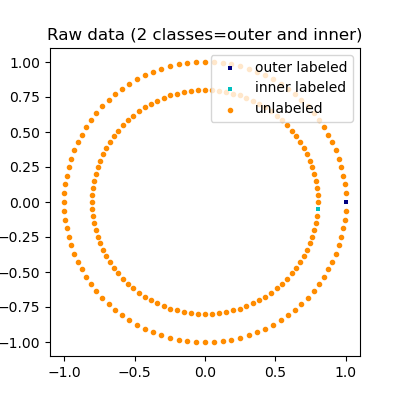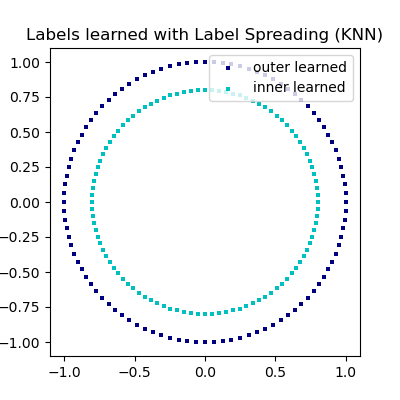Note
Click here to download the full example code or to run this example in your browser via Binder
Label Propagation learning a complex structure¶
Example of LabelPropagation learning a complex internal structure to demonstrate “manifold learning”. The outer circle should be labeled “red” and the inner circle “blue”. Because both label groups lie inside their own distinct shape, we can see that the labels propagate correctly around the circle.
# Authors: Clay Woolam <clay@woolam.org>
# Andreas Mueller <amueller@ais.uni-bonn.de>
# License: BSD
We generate a dataset with two concentric circles. In addition, a label is associated with each sample of the dataset that is: 0 (belonging to the outer circle), 1 (belonging to the inner circle), and -1 (unknown). Here, all labels but two are tagged as unknown.
import numpy as np
from sklearn.datasets import make_circles
n_samples = 200
X, y = make_circles(n_samples=n_samples, shuffle=False)
outer, inner = 0, 1
labels = np.full(n_samples, -1.0)
labels[0] = outer
labels[-1] = inner
Plot raw data
import matplotlib.pyplot as plt
plt.figure(figsize=(4, 4))
plt.scatter(
X[labels == outer, 0],
X[labels == outer, 1],
color="navy",
marker="s",
lw=0,
label="outer labeled",
s=10,
)
plt.scatter(
X[labels == inner, 0],
X[labels == inner, 1],
color="c",
marker="s",
lw=0,
label="inner labeled",
s=10,
)
plt.scatter(
X[labels == -1, 0],
X[labels == -1, 1],
color="darkorange",
marker=".",
label="unlabeled",
)
plt.legend(scatterpoints=1, shadow=False, loc="upper right")
plt.title("Raw data (2 classes=outer and inner)")

Text(0.5, 1.0, 'Raw data (2 classes=outer and inner)')
The aim of LabelSpreading is to associate
a label to sample where the label is initially unknown.
from sklearn.semi_supervised import LabelSpreading
label_spread = LabelSpreading(kernel="knn", alpha=0.8)
label_spread.fit(X, labels)
Now, we can check which labels have been associated with each sample when the label was unknown.
output_labels = label_spread.transduction_
output_label_array = np.asarray(output_labels)
outer_numbers = np.where(output_label_array == outer)[0]
inner_numbers = np.where(output_label_array == inner)[0]
plt.figure(figsize=(4, 4))
plt.scatter(
X[outer_numbers, 0],
X[outer_numbers, 1],
color="navy",
marker="s",
lw=0,
s=10,
label="outer learned",
)
plt.scatter(
X[inner_numbers, 0],
X[inner_numbers, 1],
color="c",
marker="s",
lw=0,
s=10,
label="inner learned",
)
plt.legend(scatterpoints=1, shadow=False, loc="upper right")
plt.title("Labels learned with Label Spreading (KNN)")
plt.show()

Total running time of the script: ( 0 minutes 0.124 seconds)
